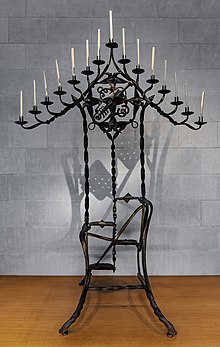Tenebrae
Tenebrae (Latın dilində "qaranlıq" deməkdir) — Qərb Xristianlığının Pasxa günündən əvvəlki üç gün ərzində keçirilən və şamların tədricən söndürülməsi, "strepitus" və ya "yüksək səs" ilə xarakterizə olunan dini mərasimidir. Mərasim sona yaxın tam qaranlıqda keçir.

| İsanın ölməsi və dirilməsi seriyasından olan məqalələr  Nəzəriyyələr Digər Başqa baxışlar |
Xristianlıq |
Tenebrae əvvəlcə Müqəddəs Həftənin son üç gününün (Müqəddəs Cümə axşamı, Yaxşı Cümə və Müqəddəs Şənbə) və əvvəlki günlərin (Müqəddəs Çərşənbə, Müqəddəs Cümə axşamı və Mübarək Cümə) axşamlarında xüsusi şənliklərin müşayiəti ilə qeyd edilməsi idi. Həmin bu şənliklərdə xüsusi üçbucaqlı şamlıq üzərində yandırılan şamlar nümayiş etdirilirdi.[1][2]
Tenebrae adlanan müasir qeydedişlər Yeddi Son Sözə və ya İsanın Əziyyətinin oxunuşlarına əsaslanaraq tamamilə fərqli məzmun və quruluşa malik ola bilərlər. Onlar Müqəddəs həftənin yalnız bir günündə, xüsusən Casus Çərşənbəsində (Müqəddəs Çərşənbə) keçirilə bilərlər.[3][4] Əsasən gündüz saatlarında keçirilə və şamların sayı da dəyişə bilər.[5]
Bu cür liturgik Tenebrae qeydedişləri indi Katolik Kilsəsinin Latın liturgik ayinlərində, Lüteranlıqda, Anqlikanizmdə, Metodizmdə, İslah edilmiş kilsələrdə və Qərb Rite Pravoslavlığında mövcuddur.[6]
İstinadlar
redaktə- ↑ Kosloski, Philip. Into the darkness of Good Friday: The ancient liturgy of Tenebrae. 12 April 2017. 17 April 2019 tarixində arxivləşdirilib. İstifadə tarixi: 17 April 2019.
On each day of Tenebrae (Spy Wednesday, Holy Thursday and Good Friday) a special triangular candelabra (called a Tenebrae hearse) is displayed, traditionally holding 15 candles.
- ↑ Webster's New World College Dictionary (2014) Arxivləşdirilib 2024-03-29 at the Wayback Machine defines Tenebrae as "a Holy Week night service (Wednesday through Friday), formerly widely observed in the Western Church, consisting of group recitation of Matins and Lauds of the following day in commemoration of Christ's death and burial". Collins English Dictionary Arxivləşdirilib 2021-04-27 at the Wayback Machine (British usage) gives: "(formerly) the matins and lauds for Thursday, Friday, and Saturday of Holy Week, usually sung in the evenings or at night.
- ↑ Kosloski, Philip. "What is "Spy Wednesday"?" (ingilis). Aleteia. 28 March 2018. 17 April 2019 tarixində arxivləşdirilib. İstifadə tarixi: 17 April 2019.
From Wednesday onward, Judas secretly watched for a chance to turn Jesus over to the chief priests, and so many Christians labeled this day as "Spy Wednesday." In the same vein various cultures reflected the somber mood of this day by calling it "Black Wednesday" or "Wednesday of Shadows," which also corresponds to the liturgical rite of Tenebrae that is celebrated on this day.
- ↑ Book of Occasional Services (ingilis). Protestant Episcopal Church in the United States. 2018.
In this book, provision is made for Tenebrae on Wednesday evening only, in order that the proper liturgies of Maundy Thursday and Good Friday may find their place as the principal services of those days.
- ↑ Boonstra, Harry. "Tenebrae". Reformed Worship. 1986. 27 March 2018 tarixində arxivləşdirilib. İstifadə tarixi: 27 March 2018.
Tenebrae services today, usually held on one day instead of three, follow many of the ancient customs. The pastor and members of the congregation read a number of Scripture passages— either the traditional fourteen or fewer. Often these passages are not psalms but rather portions of the Passion story. But no matter which Scripture and music are selected, the pattern of extinguishing the candles (and the overhead lights) and restoring the Christ candle remains the same. Some churches accentuate the darkness by tolling the bells.
- ↑ Ruehlmann, Greg. "In the Dark". Busted Halo. 21 March 2008. 18 April 2019 tarixində arxivləşdirilib. İstifadə tarixi: 18 April 2019.
It has not been popular in decades, and it would be misleading to call it a "best-kept secret" of the Catholic Church—it's celebrated by some mainline Anglican and Lutheran communities as well.